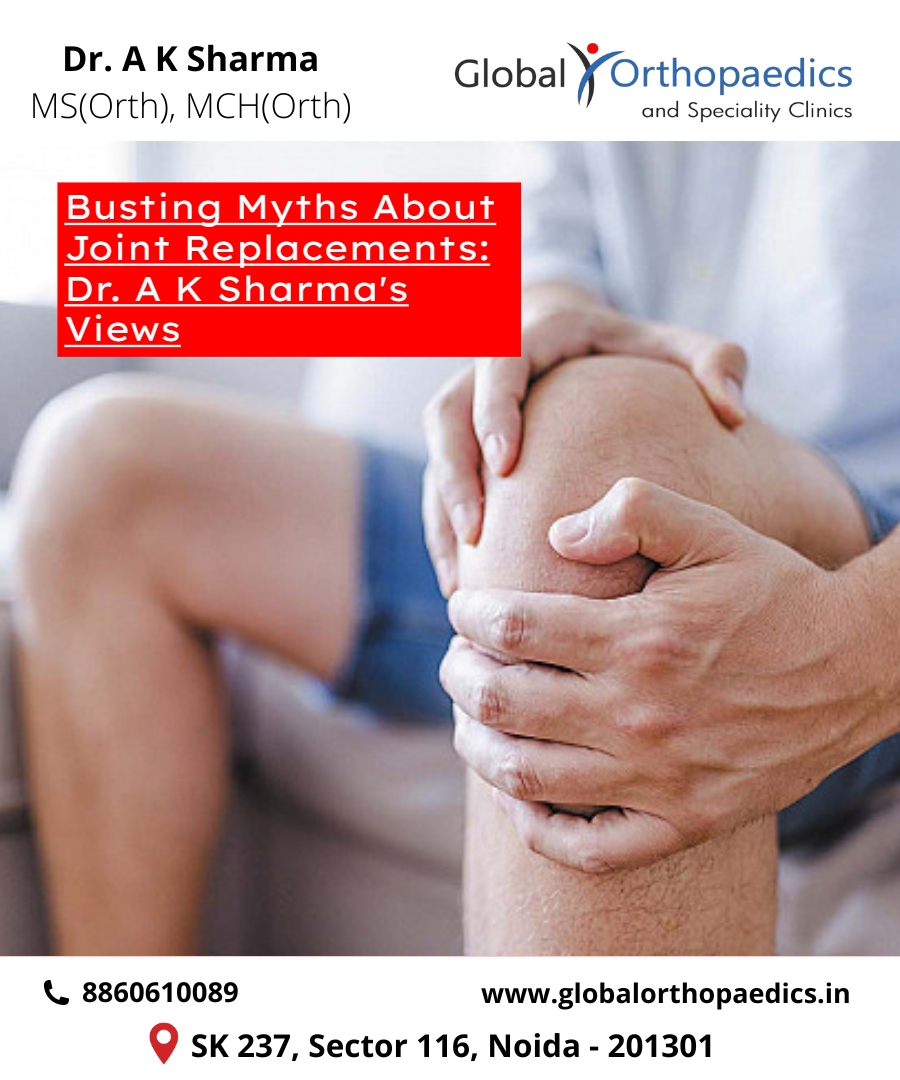+918860610089

This is your website preview.
Currently it only shows your basic business info. Start adding relevant business details such as description, images and products or services to gain your customers attention by using Boost 360 android app / iOS App / web portal.
Best Orthopaedic Surgeon in Noida Busting Myt...

Best Orthopaedic Surgeon in Noida Busting Myths About Joint Replacements: Dr. A K Sharma's Views Because joint pain may make daily living extremely difficult, many people think about getting their joints replaced. Nonetheless, a number of widespread misconceptions deter people from having a procedure that could spare them from years or even decades of agony. Dr. Ashok Kumar Sharma, a specialist in joint replacement surgery, dispels a few misunderstandings that frequently cause patients experiencing joint discomfort to struggle with making decisions. Myth 1: Put Off Getting A Joint Replacement As Long As You Can Reality: When pain substantially interferes with your everyday activities, it's critical to seek examination, as Dr. A K Sharma emphasized. "It's critical to schedule an assessment when pain substantially lowers your quality of life, " he said. Many patients wait too long because they are afraid of the healing process, according to Dr. Ashok Kumar Sharma. He said most patients have a significant improvement in their quality of life following surgery, even if recovery may feel overwhelming. According to the best orthopedic surgeon in Noida, waiting too long and carrying on with your pain management may hinder the recovery from surgery. The activity level we may anticipate from most patients a year following surgery is often similar to that of the patient a year prior to surgery. Myth 2: The Lifespan of Joint Replacements Is Short Reality: Joint replacements now last much longer thanks to developments in implant design and manufacturing. "Most of these joint replacements are going to last three or more decades, " promised Dr. A K Sharma. Myth 3: The Only Treatment for Joint Pain Is Joint Replacement Reality: Dr. Ashok Kumar Sharma outlined a number of treatment alternatives, dispelling the myth that a joint replacement is the only choice for treating joint discomfort. He clarified, saying, "While it is not the only choice, joint replacement is undoubtedly an option for people with moderate to severe arthritis. Before undergoing surgery, some patients can experience significant relief from nonsurgical treatments such physical therapy, medication, injections, and bracing. Myth 4: Your Age Shouldn't Prevent You From Getting A Joint Replacement Reality: The idea that age is a barrier to joint replacement was refuted by Dr. Sharma. According to best orthopaedic surgeon in Delhi NCR, joint replacement is a treatment option that can be considered by people of different ages. As a matter of fact, he had performed surgery on a patient who was in their late 80s and is now able to walk once more. He acknowledged that joint replacement is a more difficult discussion for younger individuals. Young people who have joint replacement surgery face societal stigma. However, you shouldn't wait to get older before looking into possibilities for pain treatment if you are experiencing significant arthritis-related pain in your 30s and you're willing to accept the possibility that you may someday require another replacement. Myth 5: People Who Are Overweight Cannot Get Joint Replacement Surgery Reality: Given that being overweight carries greater risks for surgery and other conditions, weight is undoubtedly an important consideration. But Dr. Ashok Kumar Sharma pointed out that weight is only a statistic, just like age. Most people who are overweight will not experience any problems throughout the operation. If you can recuperate from surgery, you are undoubtedly a suitable candidate. He clarified that dietary status is important for healing. Surgery is usually safe to proceed if patients are eager to move forward and are aware of the higher risks of complications. Myth 6: Activity Is Limited by Joint Replacement Reality: As a general rule, most patients will return to their pre-surgery activity level one year later. "I'm sure a lot of people who have been dealing with long-term pain may have avoided some of the higher impact activities, like long-distance running" explains Dr. A K Sharma in clarification. However, the likelihood that you will be able to resume such activities around a year after surgery is high if you have been able to do so in the last year. Myth 7: Hospital Recuperation Will Take Weeks Reality: This myth's historical foundation was acknowledged by Dr. Ashok Kumar Sharma. Even ten or fifteen years ago, it was probably the case that patients would stay in the hospital for a week or two following surgery. As these procedures are thought of as outpatient procedures, you are able to return home the same day. Who should stay one or two nights in the hospital and who can return home the same day depend on a variety of circumstances. As soon as it is safe to do so, the aim is for patients to recover at home with their families. Myth 8: There Is a High Chance of Problems Reality: Between two and three percent is a minimal overall risk of problems. "The majority of that risk i

